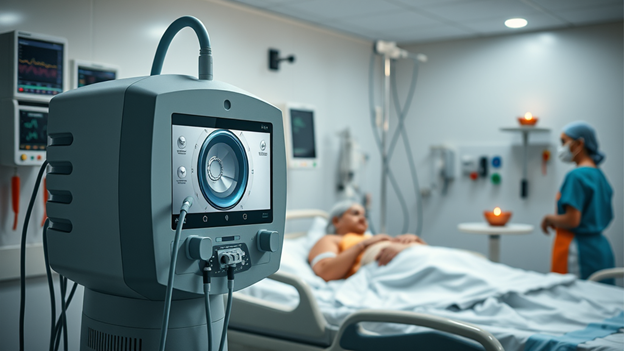When emergencies happen, medical ventilators become true lifesavers. Their primary role is to help people breathe when they can’t do it on their own. In our blog today, we’ll explore how these machines work, when they are used, and why they matter so much.
We’ll also look at the kinds of emergencies where they’re most needed, debunk some myths, and share stories of people who found hope through these machines. Finally, we’ll take a peek at innovations making ventilator machines more effective.
Understanding Medical Ventilators
A medical ventilator is a device that helps people breathe if they’re experiencing breathing difficulties. These devices are essential in hospitals, especially in intensive care units (ICUs), for patients who can’t breathe adequately on their own.
There are several medical ventilator types:
- Mechanical ventilators: Often found in hospitals, they assist or take over breathing.
- Portable ventilators: Suitable for emergencies and in ambulances.
- ICU ventilators: These are high-tech and used for critically ill patients needing constant support.
A ventilator machine pushes air into the lungs and helps remove carbon dioxide. In this way, it works as a breathing aid, ensuring oxygen gets to a person’s vital organs. This system, known as positive pressure ventilation medical, mirrors the body’s natural breathing process, filling in when someone can’t do it naturally.
Scenarios Requiring Ventilator Intervention
Sometimes, a person might need a medical vent due to severe health problems. Conditions like pneumonia or lung injuries often require this aid.
Emergencies include:
- Trauma cases where the body is badly injured and breathing stops.
- Severe illnesses, such as COVID-19, where breathing becomes extremely difficult.
For example, during the COVID-19 pandemic, an enormous number of patients relied on ICU ventilator types to survive. These machines were essential for those who experienced respiratory failure, providing the necessary support until their breathing could return to normal.
Life-Saving Role of Ventilators Explained
Medical ventilator machines are crucial in maintaining life-sustaining oxygen levels. They either assist the natural breathing process or completely replace it for a period.
These machines give the body precious time to heal. For patients, this can mean the difference between life and death. They can stabilize breathing, keep oxygen high, and offer the body a chance to recover from severe injuries or diseases.
Stories abound of patients like John, who, after suffering a severe lung infection, credited his survival to a ventilator machine. Patient stories like these highlight the machine’s role as a bridge to recovery, giving hope to many families.
The Ventilator Experience: Myths & Realities
When someone is put on a ventilator machine, a process known as intubation often takes place, where a tube is inserted into their throat to help with breathing.
Many believe it to be a painful procedure. However, efforts are made to ensure that patients remain comfortable, often using sedatives.
There are myths about the dependence on a medical vent. Some think once you’re on it, you can’t come off. But mostly, it’s a temporary measure. Over time, teams work to help patients breathe on their own again.
Being on a ventilator can affect a person’s mindset, causing stress or anxiety. Doctors and nurses are trained to help patients and families navigate these emotional landscapes, ensuring a compassionate journey towards recovery.
Technological Advances in Ventilator Machines
Modern ventilator machines have seen many innovations. They’ve become more advanced in how they help a patient breathe. Developments focus on making functionalities better and outcomes more favorable.
Portable ventilators have gained prominence, being used in ambulances and extreme emergency situations. Additionally, smart technology now allows some ventilators to adjust settings based on a patient’s needs automatically, making them even more effective.
Expertise in Operating Ventilators
Operating a medical ventilator requires skilled professionals. Doctors and nurses in ICUs are specially trained to manage these machines.
Respiratory therapists play a critical role. They continuously monitor patient conditions and adjust ventilator settings as needed. Their expertise ensures that the use of ventilator machines is optimized for every individual patient situation.
A Global Perspective on Ventilator Availability
During recent global health crises, many regions faced ventilator shortages. This was particularly evident in under-resourced areas, where the demand far outstripped the supply.
Countries worldwide have been working to improve their supplies. India, for instance, faced significant challenges. Attention to these shortages has reinforced the importance of having enough ventilator machines available everywhere, especially where resources are limited.
Concluding Insight on Medical Ventilators
In emergencies, medical ventilators are indispensable tools. They support life when breathing becomes nearly impossible.
As we move forward, technological advancements promise even better solutions, like smarter ICU ventilator machines. Hospitals are gearing up to ensure they are ready for future challenges, emphasizing preparedness and innovation.
The role of medical ventilators in saving lives remains critical, and as they improve, they continue to bring hope and breath where it’s needed the most.
Schedule your consultation at Sun Hospitals today and get expert care for Guillain-Barré Syndrome. Our specialists are ready to guide you toward a healthier tomorrow.


